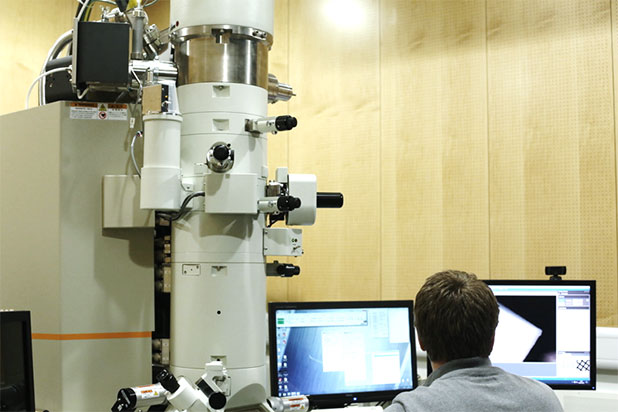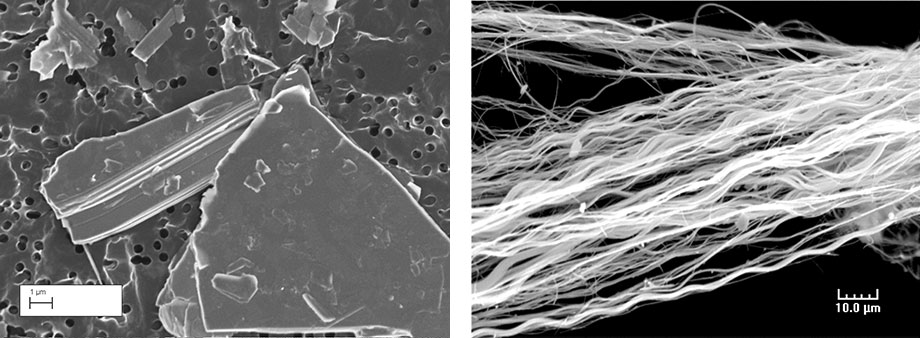When BBC journalist Phoebe Keane was worried about whether there was asbestos in her make-up, she turned to Brunel University London’s Experimental Techniques Centre for help.
Asbestos is a family of naturally occurring minerals that form long fibres with properties that seemed wonderful to previous generations. A superb insulator that’s fire-resistant and mechanically strong, asbestos was used in buildings, ships, brake pads, ironing board covers and many other places – until it was banned in the UK in 1999 because of health risks.
The very properties that made those long fibres so useful made them devastating when they were breathed in, causing illnesses such as mesothelioma, an incurable cancer.
So why might make-up products, bought from the high street, contain asbestos? As Phoebe explained in her ‘Talc Tales’ series of BBC Radio 4’s How They Made Us Doubt Everything, broadcast last week and available on BBC Sounds, asbestos often exists alongside talc in the ground – so when you mine one, you can also get the other.
Talc has been used by itself and as an ingredient in cosmetics as a soft, lubricating powder to reduce clamminess. It comes with its own health concerns, which is why some cosmetics companies use corn starch instead of talc for baby powder. But still, as Phoebe noticed, talc was listed as an ingredient in products in her own make-up bag.
Brunel’s Experimental Techniques Centre – the ETC – is one of only two testing laboratories accredited by UKAS for asbestos analysis using transmission electron microscopy (TEM). Using a TEM to inspect micrograms of solids or millilitres of liquids, ETC asbestos analysts can spot a single asbestos fibre, if it’s present.

The TEM in action
And that’s what happened in samples from two of the eight talc-containing make-up products provided by Phoebe: a single asbestos fibre in each.
Dr Ashley Howkins, the ETC’s Lead Scientific Officer for electron microscopy, carried out the analysis and was interviewed by Phoebe for episode 5, ‘Talc on trial’. Working in a controlled environment, Dr Howkins suspended a sample of dry shampoo in filtered water, ultra-sonicated it, filtered it and prepared a sequin-sized disc, which he then examined under the electron microscope.

Images of talc sheets (left) and asbestos fibres (right) taken with a scanning electron microscope at the ETC
Dr Howkins found an asbestos fibre. How was he sure, Phoebe asked? “Has it got an aspect ratio of greater than 3 to 1? Yes, it does,” Dr Howkins said, referring to how asbestos fibres are always longer and thinner than a 3-by-1 block of Lego. He also checked the chemistry, and then came onto the electron diffraction. “It’s showing you how the atoms are layered, and the measurement can tell you whether or not it’s a talc or asbestos fibre,” he said.
Phoebe then narrated while Dr Howkins loaded up a sample taken from a well-known brand’s eyeshadow palette – and again, he found one fibre. “It’s certain that it’s asbestos, based on the chemistry, morphology and the electron diffraction pattern,” he said.

Dr Ashley Howkins
Later on in the episode – the last in the hard-hitting series – Phoebe spoke to mesothelioma expert Dr Astero Klampatsa in the Institute of Cancer Research. “Using a beauty product that might contain one fibre of asbestos poses minimal risk, but there is a risk there,” Dr Klampatsa said. She explained that if someone uses that product over time, continuously, then the risk increases, because it’s additive. She concluded by saying “I would advise avoiding any unnecessary exposure. I mean, I would personally choose a talc-free product.”
Phoebe hopes that her documentary series can help people make informed decisions about the make-up they’re choosing.
Listen to ‘Talc Tales: 5. Talc on trial’ on BBC Sounds
For a full list of the Experimental Techniques Centre’s analytical services, and to get in touch with an enquiry, visit the ETC website
Reported by:
Joe Buchanunn,
Media Relations
+44 (0)1895 268821
joe.buchanunn@brunel.ac.uk